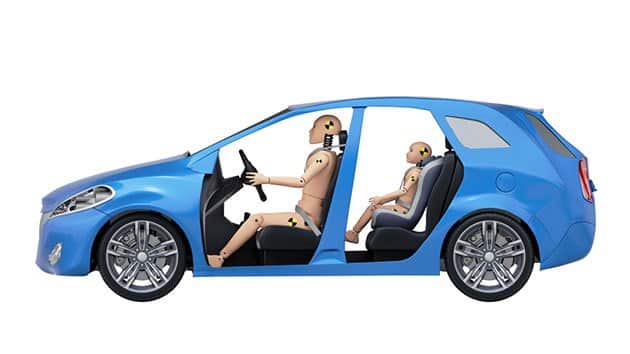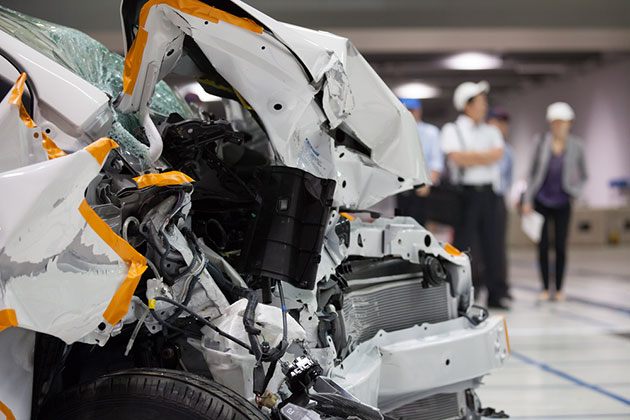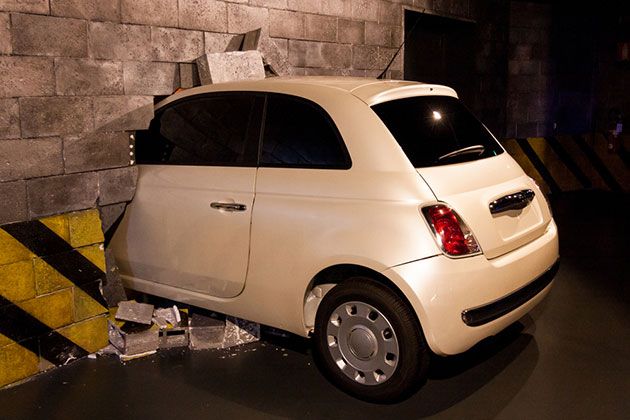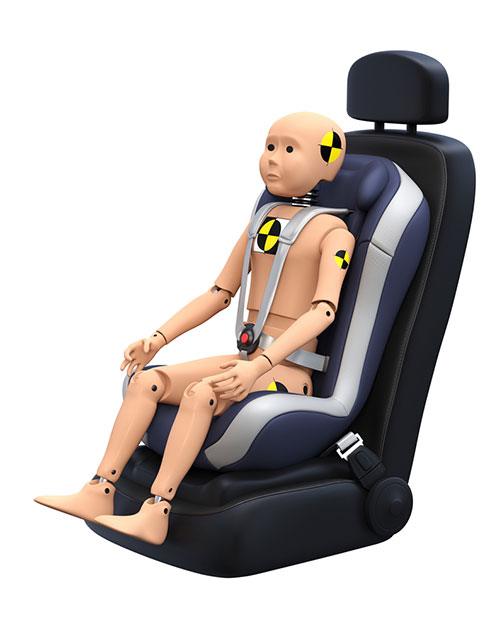We've researched and gathered all information regarding car seat crash test ratings. In this article, you will find:
- What is crash testing, and how it works for kids
- Types of crash testing
- How to read and understand crash test results
- Differences in safety standards
- Types of other safety tests
- Safest car seat brands and models.
Let's get to the point.
More...
Table of Contents
- Car Seat Crash Testing: All Information in One Place
- What is a car seat crash test & how crash testing works
- Who performs car seat crash testing?
- Types of tests for a child car seat
- Can manufacturers test child seats as well? What are the criteria?
- Differences in US, EU, and CA safety standards
- Other car seat safety test types
- Best car seats with the highest safety ratings
- FAQs
- Final Words
Car Seat Crash Testing: All Information in One Place
Below you can find all the crucial factors the federal agencies and manufacturers follow when crash-testing car seats. Let's take a close look.

What is a car seat crash test & how crash testing works
Crash testing, also known as dynamic testing, refers to a properly secured crash test dummy into a car seat.
The seat is adequately installed on the crash test bench. The experts then accelerate and decelerate at a specific speed to stimulate frontal collision at 30mph (48km/h.)
The dummy, clothing, seating position, harness, and seat belt are regulated by federal safety standards. Such standards are critical for repeating tests at different lab facilities.
Who performs car seat crash testing?
Two organizations are responsible for executing and collecting car seat crash test results:
1. National Highway Traffic Safety Administration - NHTSA
2. Insurance Institute for Highway Safety - IIHS.
Both agencies conduct extensive vehicle and child restraint system tests to evaluate crash protection and passengers' safety.
However, there's a difference between the two organizations.
The Federal government runs the National Highway Traffic Safety Administration. However, the Insurance Institute for Highway Safety - IIHS is a non-profitable facility founded and run by insurance companies.
Types of tests for a child car seat
There are various tests for multiple child car seats, including: infant car seat, convertible car seat, and booster seat.
The tests also comply with the NHTSA and IIHS vehicle safety testing, and the agencies use the specific ratings to evaluate the overall safety of the passengers. So let's take a further look.
NHTSA vehicle & car seat rating standards
The NHTSA applies the 5-star rating to test every new vehicle. The more stars a car earns, the better it's performed in the tests. More stars equal safer cars, as the agency states. One star means the lowest rating, while five stars mean the highest rating.
To determine the safety of vehicles, the NHTSA uses four tests:
You can find more information here.
The NHTSA also rates all child car seats (infant car seats, convertible car seats, and booster seats) with their Ease-of-Evaluation standards, in addition to these tests.
The car seat manufacturers self-certified all car seats under the federal agency rates. These must follow Federal Motor Vehicle Safety Standards 213 - FMVSS, including the strict car seat safety tests and performance standards.
There are four basic evaluation categories:
1. Evaluation of instructions - inspects the clarity and content of the instructions for the child restraint system.
2. Vehicle installation features - examines the ease of using parts to install child car seats in motor vehicles.
3. Evaluation of the labels - scans the clarity and content of the labeling attached to the child safety seat.
4. Securing the child - investigates the ease of using features to ensure a child is safely and securely in the car seat.
What do the NHTSA ratings mean?
The officials use the following rating system to help you evaluate the four basic Federal law categories listed above. You can find more information here.
IIHS vehicle and car seat ratings
The IIHS uses slightly different crash test ratings, contrary to the NHTSA's 5-star standards. The IIHS includes:
- Good
- Acceptable
- Marginal
- Poor.
The IIHS also has different crash evaluation types than the NHTSA. These include:
However, the IIHS also tests headlights, seat belts, and front crash prevention to ensure the safety of all passengers.
What do the IIHS ratings mean?

The IIHS specializes in testing vehicle seat belt systems and booster seats, as these units are the only connectors keeping boosters stable in motor vehicles, unlike harnessed car seats.
The Institute divides booster seats into four different categories:
Remember that the shoulder and lap belt fit to refer to adults, not children. However, with proper installation scores, the car seats ensure the LATCH system and vehicle belt also work correctly. That way, the lap belt covers the upper thighs while the shoulder belt crosses snugly over the child's shoulder.
You can find the testing performance here and see more information for each process step.
Can manufacturers test child seats as well? What are the criteria?
Manufacturers can also conduct crash test ratings and choose the following:
- Best rear-facing car seat
- Best convertible car seat
- Best booster car seat, based on their criteria.
However, manufacturers must refer to the International Consumer Research & Testing - ICRT. It's a global organization assessing consumer products and conducting safety tests for child restraints with the ADAC and Stiftung Warentest.
The ADAC is a central testing agency known as one of Europe's leading testers of child car seats.
The Stiftung Warentest is a German consumer association, partly funded by the public to ensure its independence, and doesn't accept advertising.
How do manufacturers test the seats?
The Stiftung Warentest has the following criteria when testing seats:
Finally, the scores vary from best to worst. In addition, an overall star scoring is given from one to five to serve parents who choose better when looking for the best child car seat.
However, all manufacturers and independent agencies must submit the average crash test results before the launching and overall crash test data to the NHTSA to approve them and confirm their launching on the market.
Therefore, not all car seats can be launched, especially if they don't meet safety features and other standards (installation, ease of use, etc.). Only those seats with impressive crash test results will be approved for the domestic and global markets.
Making sense of crash test results
Once you conduct the tests, it's time to read and understand the results. But how can you know if they are meaningful? Read below.
The values presented in the results are compared against the standards set by regulatory agencies.
The more distance between the standard limits and measured results, the larger the amount of a seat that exceeds standards is.
Different seat types have various measurement types taken during crash testing. For instance, some values measured for rear-facing seats aren't included for forward-facing seats or booster seats, and vice versa. These values are meant to reflect whether the movement of the seat and dummy shows an increased risk for injury.
Remember that all tests require figures for optimal performance and possible mistakes. However, the data can vary from one agency to another or among manufacturers.
For example, Clek uses percentages to show the ratings of their baby gear, and if the data fall below the maximum limit, the seats are optimal. On the other hand, European agencies, such as ADAC, use numbers 1-5 to show their results. But, the lower the score, the better the results.
In addition, Which? - the UK testing facility also uses percentages to show the overall test scores, but the officials use stars 1-5 to rate the car seats.
So, it would help to search for their criteria and compare the values with the NHTSA or EURO NCAP crash test results. You can find the best car seat depending on the standards you must follow - US or EU.
Differences in US, EU, and CA safety standards
A new car seat must meet all safety regulations to be used in a motor vehicle. Otherwise, children cannot use restraint systems at all. However, the standards and rules vary from one state to another and between countries.
Let's see the similarities and differences between the US, CA, and EU car seat safety standards.
US vs. EU
For instance, testing speed is different in the EU and US. The EU speed measures 31 mph, whereas the US is 30 mph. The EU standards comply with the ECE R44 and ECE R129, while the US follows the FMVSS 213 standards. Although many caregivers state the EU standards are better in safety, there's not much difference in the tests.
However, the EU seats have side-impact protection following the 2013 i-Size regulation changes. The NHTSA proposed similar standards, but there haven't been any changes to the restraint systems.
In addition, the EU standards allow parents to release the harness in a single motion. The seats don't have chest clips, although they are five-point harness seats. The EU uses a more angled set of straps and adhesive shoulder strap covers to keep the straps on a child's shoulders.
In the US, the chest clip keeps the straps on the shoulders. The straps can be wider on the shoulders when the chest clip is too low. If it's too high, the clip can be in the way of the child's throat. Both standards prevent car accident injuries in the forward or rear-facing position.
EU seats have come with tether straps since 2014, according to the ECE R129 regulation. Before 2014, the seats used the ISOFIX system to reduce head excursions.
On the other hand, the US standards verify that the seats have used top tethers since 1999 for better stability and protection.
Finally, the installation is also different. The EU seats are either ISOFIX or lap and shoulder belts only. The US seats have straps, lower anchors, top tethers, and combinations. Many EU seats won't allow a lap belt only, so they can't be used for aircraft, unlike US seats.
But, all seats must be installed in the vehicle's back seat regardless of the type. You can install them behind the passenger seat only when you must put another child in the central position of the back seat.
You should never install a seat in the front passenger seat, or if you must, please deactivate the airbag system.
US vs. CA
The CA standards require the Canadian national safety mark - CNSM and other safety precautions- and offer educational car seat clinics.
However, the US rules state the seats must have labels saying they're approved for motor vehicle and aircraft use. But, if your seat doesn't have the CA mark and you want to cross the border, you won't be able to.
The LATCH system requirements are the same for both countries. However, according to the CMVSS, they have different dynamic testing methods than the US. For instance, the CA rules request tested seats with a lap/shoulder belt, UAS, or lap belt.
On the other hand, the US standards do not require the lap/shoulder test. And as the laws vary from state to state/province to province, you can refer to these two tables to examine all details in the US and Canada.
Other car seat safety test types
According to the NHTSA, there are three other types of safety tests to protect your children from car accidents. These include: sled tests, static tests, and inversion tests.

1. Sled tests
Sled testing serves to test seating apparatuses in a simulated crash.
A sled test analyzes automotive seats, primary and secondary restraint systems, and seat belts. It determines their safety in the front, rear, or side impact crashes.
2. Static testing
The static testing requirements refer to standards that are not related to crash testing yet are essential to confirm the integrity of the components of a car seat.
For example, the harness buckle has specific rules concerning the minimum and maximum amount of pressure necessary to release the harness before and after crash testing. This helps ensure that it's not too easy for a child to unbuckle but that it's possible to unfasten the buckle after a crash.
3. Inversion tests
In Canada, any rear-facing seat or forward-facing seat must pass inversion testing. Such testing ensures the infant car seat/convertible seat is approved for aircraft use.
However, this testing is optional in the USA, but once done, a manufacturer will place the FAA label or sticker confirming its aircraft use. And boosters do not undergo such tests, as they are not approved for aircraft.
The main reason is that airplanes are equipped with lap-only belts, which are not approved for boosters. So, you can only bring an infant seat/convertible seat, according to the FAA.
However, you can always refer to the NHTSA's pdf research to find more details about the procedures and results of the conducted tests.
Best car seats with the highest safety ratings
Below you can find the best car seats with the highest crash test results currently on the market, according to the IIHS and BabyGearLab. Let's see.
Best infant car seat
Chicco KeyFit 35 Infant Car Seat - Best overall infant seat
Graco SnugRide SnugLock 35 LX Infant Car Seat - Safe infant car seat with anti-rebound bar
Best convertible car seats
Graco 4Ever DLX 4 in 1 Car Seat - Best all-in-one car seat
Evenflo Tribute LX Convertible Car Seat - Best convertible car seat for a tight budget
Best booster car seats
Britax Grow with You ClickTight Plus Harness-2-Booster Car Seat - For more weight limit
GoFit Plus Backless Booster Car Seat - Best backless booster
FAQs
Which are the three crash tests that determine a safety rating?
The IIHS uses these three crash tests to determine a safety rating:
- Driver and passenger injury tests
- Head protection tests
- Structural performance tests
Is a 3-star crash rating good?
Yes, it is good; however, it's not excellent. The rating shows average to good occupant protection, but it's not advanced or superior to those with 4 or 5 stars.
Are all car seats tested?

Yes, all car seats must be tested following the NHTSA, ADAC, ECE 44, ECE R129, or CMVSS 213, depending on your country and area.
Are boosters crash tested?
Yes, boosters are crash tested for frontal and rear impacts, but not yet to side impacts.
Final Words
We hope the guide helped you learn more about the crash testings and better understand the procedure and ratings.
Please refer to the NHTSA's guidelines for all dilemmas, and contact your manufacturers. And, always check in advance if you can use the seat in other countries and the requirements.
